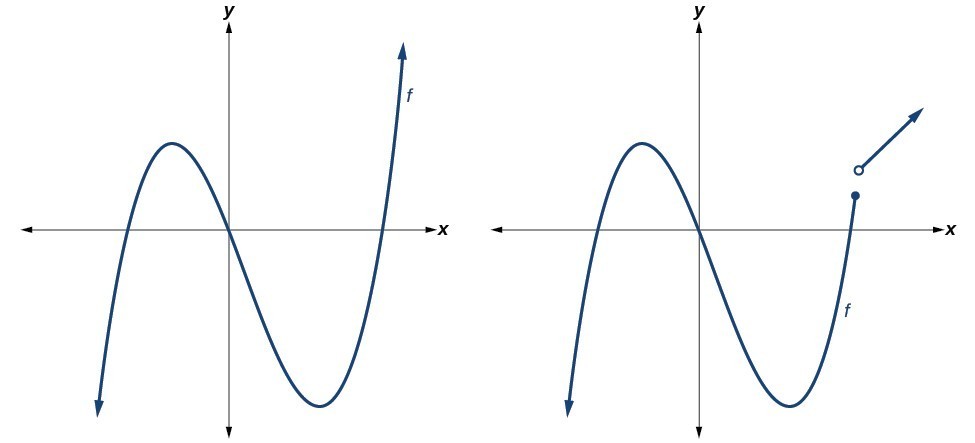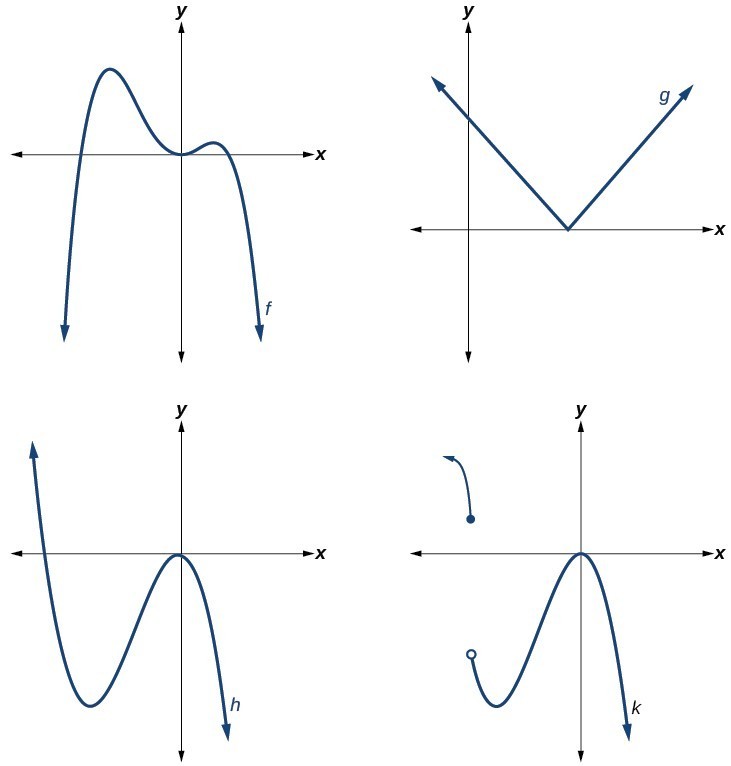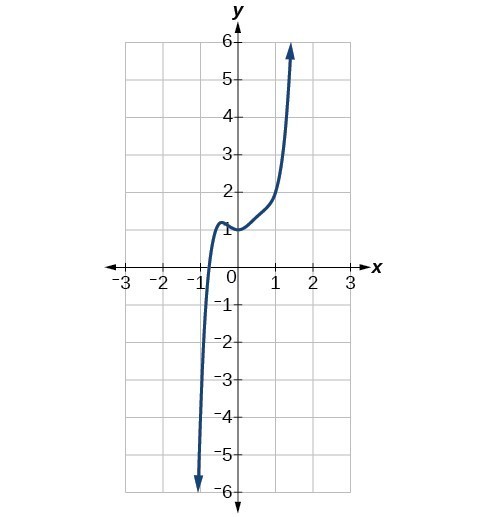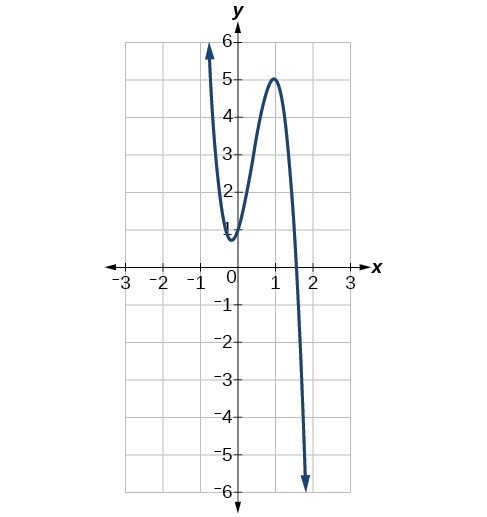Graphs of Polynomial Functions
Learning Outcomes
- Identify general characteristics of a polynomial function from its graph

Example
Which of the graphs below represents a polynomial function?
Answer:
The graphs of f and h are graphs of polynomial functions. They are smooth and continuous.
The graphs of g and k are graphs of functions that are not polynomials. The graph of function g has a sharp corner. The graph of function k is not continuous.
Q & A
Do all polynomial functions have "all real numbers" as their domain?
Yes. Any real number is a valid input for a polynomial function.
Identifying the Shape of the Graph of a Polynomial Function
Knowing the degree of a polynomial function is useful in helping us predict what its graph will look like. Because the power of the leading term is the highest, that term will grow significantly faster than the other terms as x gets very large or very small, so its behavior will dominate the graph. For any polynomial, the graph of the polynomial will match the end behavior of the term of highest degree.
As an example, we compare the outputs of a degree [latex]2[/latex] polynomial and a degree [latex]5[/latex] polynomial in the following table.| x | [latex]f(x)=2x^2-2x+4[/latex] | [latex]g(x)=x^5+2x^3-12x+3[/latex] |
| [latex]1[/latex] | [latex]4[/latex] | [latex]8[/latex] |
| [latex]10[/latex] | [latex]184[/latex] | [latex]98117[/latex] |
| [latex]100[/latex] | [latex]19804[/latex] | [latex]9998001197[/latex] |
| [latex]1000[/latex] | [latex]1998004[/latex] | [latex]9999980000000000[/latex] |
Even Degree Polynomials
In the figure below, we show the graphs of [latex]f\left(x\right)={x}^{2},g\left(x\right)={x}^{4}[/latex], and [latex]h\left(x\right)={x}^{6}[/latex] which all have even degrees. Notice that these graphs have similar shapes, very much like that of a quadratic function. However, as the power increases, the graphs flatten somewhat near the origin and become steeper away from the origin.

Odd Degree Polynomials
The next figure shows the graphs of [latex]f\left(x\right)={x}^{3},g\left(x\right)={x}^{5}[/latex], and [latex]h\left(x\right)={x}^{7}[/latex] which all have odd degrees. 
Notice that one arm of the graph points down and the other points up. This is because when your input is negative, you will get a negative output if the degree is odd. The following table of values shows this.
| x | [latex]f(x)=x^4[/latex] | [latex]h(x)=x^5[/latex] |
| [latex]-1[/latex] | [latex]1[/latex] | [latex]-1[/latex] |
| [latex]-2[/latex] | [latex]16[/latex] | [latex]-32[/latex] |
| [latex]-3[/latex] | [latex]81[/latex] | [latex]-243[/latex] |
Example
Identify whether each graph represents a polynomial function that has a degree that is even or odd. a) b)
b)

Answer: a) Both arms of this polynomial point upward, similar to a quadratic polynomial, therefore the degree must be even. If you apply negative inputs to an even degree polynomial, you will get positive outputs back. b) As the inputs of this polynomial become more negative the outputs also become negative. The only way this is possible is with an odd degree polynomial. Therefore, this polynomial must have an odd degree.
The Sign of the Leading Term
What would happen if we change the sign of the leading term of an even degree polynomial? For example, let us say that the leading term of a polynomial is [latex]-3x^4[/latex]. We will use a table of values to compare the outputs for a polynomial with leading term [latex]-3x^4[/latex] and [latex]3x^4[/latex].| x | [latex]-3x^4[/latex] | [latex]3x^4[/latex] |
| [latex]-2[/latex] | [latex]-48[/latex] | [latex]48[/latex] |
| [latex]-1[/latex] | [latex]-3[/latex] | [latex]3[/latex] |
| [latex]0[/latex] | [latex]0[/latex] | [latex]0[/latex] |
| [latex]1[/latex] | [latex]-3[/latex] | [latex]3[/latex] |
| [latex]2[/latex] | [latex]-48[/latex] | [latex]48[/latex] |
 The negative sign creates a reflection of [latex]3x^4[/latex] across the x-axis. The arms of a polynomial with a leading term of [latex]-3x^4[/latex] will point down, whereas the arms of a polynomial with leading term [latex]3x^4[/latex] will point up.
Now you try it.
The negative sign creates a reflection of [latex]3x^4[/latex] across the x-axis. The arms of a polynomial with a leading term of [latex]-3x^4[/latex] will point down, whereas the arms of a polynomial with leading term [latex]3x^4[/latex] will point up.
Now you try it.
Example
Identify whether the leading term is positive or negative and whether the degree is even or odd for the following graphs of polynomial functions. a) b)
b)

Answer: a) Both arms of this polynomial point in the same direction so it must have an even degree. The leading term of the polynomial must be negative since the arms are pointing downward. b) The arms of this polynomial point in different directions, so the degree must be odd. As the inputs get really big and positive, the outputs get really big and negative, so the leading coefficient must be negative.
Licenses & Attributions
CC licensed content, Original
- Revision and Adaptation. Provided by: Lumen Learning License: CC BY: Attribution.
CC licensed content, Shared previously
- College Algebra. Provided by: OpenStax Authored by: Abramson, Jay, et al.. Located at: https://openstax.org/books/precalculus/pages/1-introduction-to-functions. License: Public Domain: No Known Copyright. License terms: Download for free at: http://cnx.org/contents/[email protected].
